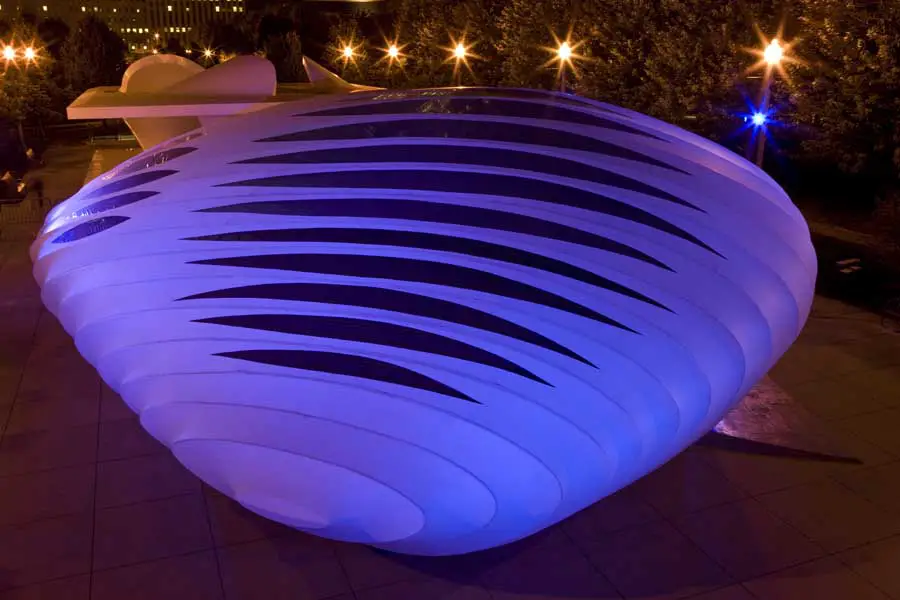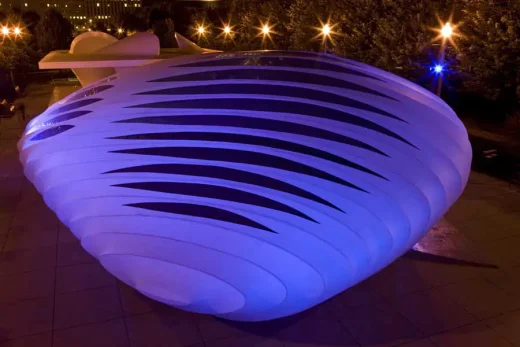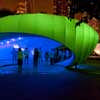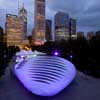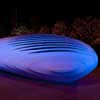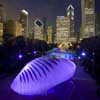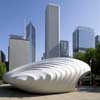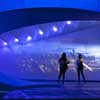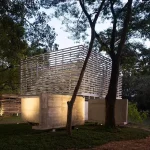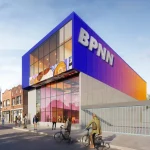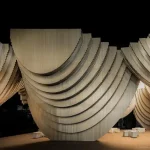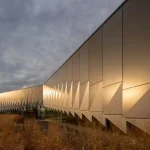Burnham Pavilion, Millennium Park, Chicago Building, Landscape Project Design, Photo
Burnham Pavilion Chicago Architecture
Millennium Park Development, Chicago design by Zaha Hadid Architects
post updated July 7, 2024
Burnham Pavilions in Millennium Park
Design: Zaha Hadid, architect
Centennial kicks off Green Legacy week with deconstruction and recycling
Aug 24, 2009
Burnham Pavilions Millennium Park
CHICAGO, October 29, 2009 – A great number of metropolitan Chicagoans and visitors to Millennium Park have experienced the Burnham Pavilions that will end their free public display on Sunday night. The Pavilions are open to the public from 10 a.m. to 11 p.m. daily through November 1.
The film installation in the Zaha Hadid pavilion starts playing at 4:30 each day and is most visible after dark, when the lighting by Dear Productions washes the innovative designs in ever-changing colors.
The bold, cutting-edge architectural statements by Amsterdam-based UNStudio and London-based Zaha Hadid Architects drew attention around the world and helped engage people throughout metropolitan Chicago in the hundreds of other exhibits, events and programs organized by 250 partner organizations commemorating the Burnham Plan Centennial.
Images courtesy of Zaha Hadid Architects © Michelle Litvin
“We asked Zaha Hadid and Ben van Berkel to inspire Chicago to think in new ways. A vast number of people have interacted with the powerful beauty of these innovative forms and discovered new ways to think about architecture and Chicago. Thomas Gray’s film inside the Zaha Pavilion challenged us to explore our past and take responsibility for our future, and visitors had an opportunity to interact with the next big plan through a kiosk installed by CMAP.
Like the ‘wow’ moment created by the huge water colors that illustrated the Plan of Chicago one hundred years ago, these pavilions have served as a call to action to plan boldly and aim high,” Said Emily J. Harris, executive director of the Burnham Plan Centennial Committee.
“The great impact of the pavilions, the sheer delight they evoked, will be missed. On Monday both temporary structures begin their next phase: to be deconstructed and recycled in support of sustainable activities in the region. This is how we are kicking off the centennial’s Green Legacy week,” Harris said.
The privately financed pavilions by two world renowned architects were a partnership of the Centennial, Chicago Department of Cultural Affairs, Art Institute of Chicago and Millennium Park Inc.
The Centennial marks the 100th anniversary of the 1909 publication of the Plan of Chicago by Daniel H. Burnham and Edward H. Bennett. The materials from both pavilions will go to the Resource Center, Chicago for reuse and recycling.
Fabric Images of Elgin will dismantle the Zaha Pavilion in two days. 3rd Coast Construction of Chicago is a deconstruction contractor and will take down the UNStudio Pavilion – built of steel and plywood – over a period of approximately three weeks.
“Removing the materials so that they can be reused with the lowest carbon footprint is our goal,” said Dan Sheehy, principal of 3rd Coast.
Bill Steers, President of the ArcelorMittal USA Foundation, Burnham Pavilion steel sponsor, said, “Steel is the most recycled material in the world – more than 250 million tons are recycled each year. As part of our commitment to sustainability, ArcelorMittal is glad that the steel used to make the Burnham Pavilion will be re-used by the Resource Center.”
About The Burnham Plan Centennial
The Burnham Plan Centennial includes more than 200 program partners from the three-state region spanning from Kenosha, Wis., through DeKalb, Ill., to Michigan City, Ind. In honor of Daniel Burnham’s 1909 Plan of Chicago, this Centennial year is stirring a region-wide community to action, working to build the best quality of life for people and planet alike.
Our region’s community foundation, The Chicago Community Trust, provided leadership funding for the Burnham Plan Centennial, and is joined by the Elizabeth Morse and Elizabeth Morse Genius Charitable Trusts as founding sponsors. Organizational and staff support for the Burnham Plan Centennial Committee is provided by Chicago Metropolis 2020.
About Millennium Park
Millennium Park is an award-winning center for art, music, architecture and landscape design. The result of a unique partnership between the City of Chicago and the philanthropic community, the 24.5-acre park features the work of world-renowned architects, planners, artists and designers.
Among Millennium Park’s prominent features are the Frank Gehry-designed Jay Pritzker Pavilion, the most sophisticated outdoor concert venue of its kind in the United States; the interactive Crown Fountain by Jaume Plensa; the contemporary Lurie Garden designed by the team of Gustafson Guthrie Nichol, Piet Oudolf and Robert Israel; and Anish Kapoor’s hugely popular Cloud Gate sculpture.
Since opening in July 2004, Millennium Park has hosted more than 16 million people, making it one of the most popular destinations in Chicago.
New Photos online 24 Aug 2009
Burnham Pavilion Chicago design by Zaha Hadid Architects
Zaha Hadid Architects’ pavilion design for Chicago’s Burnham Plan Centennial celebrates the city’s ongoing tradition of bold plans and big dreams.
The project encourages reinvention and improvement on an urban scale and welcomes the future with innovative ideas and technologies whilst referencing the original organizational systems of Burnham’s plan. The ZHA design continues Chicago’s renowned tradition of cutting edge architecture and engineering, at the scale of a temporary pavilion.
The design merges new formal concepts with the memory of bold historic urban planning. Superimpositions of spatial structures with hidden traces of Burnham’s organizational systems and architectural representations create unexpected results. By using methods of overlaying, complexity is build up and inscribed in the structure.
The pavilion is composed of an intricate bent-aluminum structure, with each element shaped and welded in order to create its unique curvilinear form.
Outer and inner fabric skins are wrapped tightly around the metal frame to create the fl uid shape. The skins also serve as the screen for video installations to take place within the pavilion.
Zaha Hadid Architects’ pavilion also works within the larger framework of the Centennial celebrations’ commitment to deliberate the future of cities.
The presence of the new structure triggers the visitor’s intellectual curiosity whilst an intensifi cation of public life around and within the pavilion supports the idea of public discourse.
The pavilion was designed and built to maximize the recycling and re-use of the materials after its role in Millennium Park. It can be re-installed for future use at another site.
Burnham Pavilion Chicago – Building Information
BURNHAM PAVILION [CHICAGO, USA]
DATE: 2009
PROGRAM: Temporary pavilion to house multimedia installation
CLIENT: Burnham Plan Centennial
ARCHITECT: Zaha Hadid Architects
Design: Zaha Hadid and Patrik Schumacher
Project Architect: Jens Borstelmann, Thomas Vietzke
Project Team: Teoman Ayas, Evan Erlebacher
LOCAL ARCHITECT: Thomas Roszak
STRUCTURAL ENGINEERS: Rockey Structures
FABRICATOR: Fabric Images
LIGHTING & ELECTRICAL: Tracey Dear
MULTIMEDIA CONTENT: The Gray Circle
4 Aug 2009
Burnham Pavilion Opening
The Burnham Pavilion by Zaha Hadid Architects is officially opened to the public in Millennium Park today, images online tomorrow
Zaha Hadid’s Burnham Pavilion Open to Public
Bold structure on display in Millennium Park
CHICAGO – August 4, 2009 – The much anticipated Burnham Pavilion by Zaha Hadid Architects (ZHA) of London, UK, has officially opened to the public in Millennium Park. The pavilion is located next to the UNStudio pavilion, which opened to the public on June 19. Both are located on the park’s Chase Promenade south.
More than 7,000 pieces of aluminum – no two alike – had to be individually bent and welded to create its curvilinear form. Then thousands of yards of fabric had to be custom tailored and tightly fit onto the interior and exterior aluminum-tube structure. This first-of-its kind installation stretched the limits of all involved – as a Burnham venue properly should – and its fabrication took longer than the original contractor expected.
“This is an artistic achievement of global proportions,” said Burnham Plan Centennial Committee executive director Emily J. Harris. “It is fabulous. Special thanks go to Fabric Images of Elgin for jumping in to complete this project as envisioned by Zaha Hadid.”
Speaking from her firm’s offices in London, Zaha Hadid said, “The pavilion is a classic vehicle for architectural manifestos because their function is not as restrictive as that of a museum or other building. This allows the architectural concepts of the pavilion to dominate.
“Fabric is both a traditional and a high-tech material whose form is directly related to the forces applied to it – creating beautiful geometries that are never arbitrary. I find this very exciting,” said Ms. Hadid, the first female winner of the Pritzker Prize for Architecture (2004), who plans to visit Chicago in September.
The ZHA pavilion’s unique curvilinear geometries required state-of-the-art fabric technologies executed by Fabric Images. Each piece of fabric was individually sewn and tensioned between the aluminum ribs.
Every evening, the inner fabric’s curving skin serves as the “screen” for a sound-and-video installation by artist Thomas Gray that impressionistically explores how the Chicago region has transformed during the past 100 years, and asks people to examine their dreams for the future. The creative multi-channel sound track was created by Lou Mallozzi of Experimental Sound Studio, Chicago.
Both the interior and exterior surfaces of the pavilion are bathed in ever-changing lighting designed by Dear Productions.
The two Burnham Pavilions by world-renowned architects, Zaha Hadid and UNStudio’s Ben van Berkel serve as focal points for the future-looking centennial of the 1909 Plan of Chicago. Their high visibility directs the public’s attention to the hundreds of exhibits, events, and other activities presented by more than 250 Centennial Program Partners in the three-state metro area.
The privately funded pavilions were commissioned by the Burnham Plan Centennial Committee working in close collaboration with the City of Chicago Department of Cultural Affairs, the Art Institute of Chicago, and Millennium Park Inc. Both pavilions were designed and built to be deconstructed and their materials re-used following the exhibit’s closing October 31. The Zaha Hadid pavilion is recyclable and can be reconstructed for installation elsewhere.
The pavilions site is augmented by a kiosk for the public to engage in “inventing the future” of the metropolitan Chicago region. An interactive touch-screen installation let’s people choose from various scenarios of the choices currently facing regional planners, and then see animations of the consequences of their choices.
This will help shape the Chicago Metropolitan Agency for Planning’s (CMAP) GoTo2040 plan to direct regional development for the next 30 years. The kiosk also shows visitors numerous other on-going Burnham Plan Centennial exhibits within walking distance of the pavilions.
Burnham Pavilion Design : Further Information
Burnham Pavilion by UNStudio
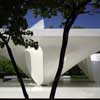

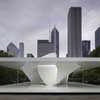
photos courtesy of Christian Richters
Millennium Park Pavilions Chicago – Background Info
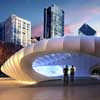
Millennium Park Pavilion
Location: Chicago, IL, USA
Chicago Architecture
Chicago Architecture Walking Tours
Also by Zaha Hadid Architects:
Eli & Edythe Broad Art Museum, Michigan, USA
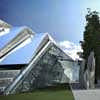
Michigan museum
Ben van Berkel of UNStudio
American Architect Studios
Comments / photos for the Millennium Park Pavilions Chicago Architecture page welcome

